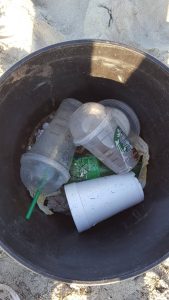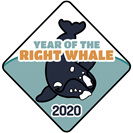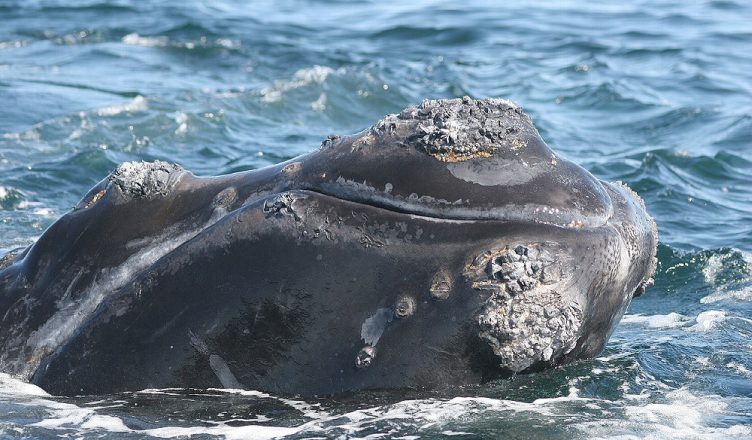With only around 400 North Atlantic right whales left in the world, the year of 2020 can potentially be a major turning point for the whales’ survival. To positively turn the tides around for right whales, we’ve compiled a list of very simple changes you can implement into your life for the new year and how to do so! Whether you choose to partake in one of these life choices, or all of them, every action you take part in to benefit right whales is making a difference.
1. Shop Locally!
 Shopping locally is beneficial for right whales for a couple of reasons:
Shopping locally is beneficial for right whales for a couple of reasons:
- When you buy food or products from grocery stores or large chain companies, your products are sometimes traveling thousands of miles just to get to the store! Buying locally means less items must travel across our oceans by boats and vessels, which means there’s less of a chance for a right whale to get struck by one. Vessel strikes are one of the biggest threats to right whales since their habitats and migration routes are located close to major ports along the coast. In fact, one of the four right whale calves that was spotted this year, only days old, was sadly already seen with a severe vessel strike wound.
- Another way shopping locally helps right whales (and all life on this planet) is that it combats climate change. Shopping locally reduces your product’s mileage, which means less energy was used to make the item and transport it. Right whales are directly affected by climate change since it warms the Gulf of Maine and drives their prey away in search of colder waters.
Start to check out some of your local farmer’s markets and shops nearby to become an avid local shopper! Don’t forget that you’re not only helping right whales and all other wildlife, but you’re doing your part to help the local economy as well!
2. Refuse Single Use Plastic

It’s becoming a no-brainer to everyone that plastic is one of the biggest threats to our oceans and all life within them, including right whales. It’s difficult to say exactly how much plastic is in our oceans, but scientists predict roughly 8 million metric tons enters the ocean each year!
Single-use plastic items like straws and water bottles are discarded quickly, and most of the time end up in the ocean after being littered, discarded improperly, or blown off platforms and into the sea.
Ocean plastics pose a threats to right whales if accidentally ingested while feeding which can lead to serious injury or death. Not only that, but plastic never fully breaks down, and instead turns into microplastics – tiny plastic particles easily ingested by right whale prey. Ocean plastics are also an excellent surface for collecting pollutants such as DDT that ends up in the ocean from runoff. The combination of ingesting microplastics along with pollutants means there’s a lot of toxins building up in a whale and stored within their blubber; leaving them more susceptible to disease and illness. Entanglement in fishing gear is already one of the biggest threat to right whales, let’s not add to the threats with single use plastic items.
For further information, click here to read more about how plastic affects whales.
3. Talk About Them
 One of the easiest ways to help right whales is simply to talk about them! More people than you think have no clue what a right whale even is. It’s important to talk about the problem with your friends and family, because the more people that are informed and willing to help, the better chances the right whales have at surviving.
One of the easiest ways to help right whales is simply to talk about them! More people than you think have no clue what a right whale even is. It’s important to talk about the problem with your friends and family, because the more people that are informed and willing to help, the better chances the right whales have at surviving.
For right whales to survive, we need everyone on board making smart life choices to protect the whales, but people can’t do that if they don’t know there’s a problem in the first place! By following the Year of the Right Whale Instagram, Facebook, and Twitter, you can easily spread information to your followers on issues facing right whales and how they can help solve them.
4. Stay Informed
By staying informed on right whale news and information, you can stay up to date on the best ways you can help the whales. As mentioned prior, one easy way to do this is by following social media accounts such as the Year of the Right Whale Instagram, Facebook, and Twitter, that provide helpful tips on how to be a part of saving the species, along with news and updates in the right whale world!
5. Get Involved
 By getting involved with any of the recommend resolutions above, you’re doing a major service for right whales, but you can take it further by getting even more involved! Signing up for a local beach cleanup prevents right whales from ingesting/becoming entangled in plastics and other debris.
By getting involved with any of the recommend resolutions above, you’re doing a major service for right whales, but you can take it further by getting even more involved! Signing up for a local beach cleanup prevents right whales from ingesting/becoming entangled in plastics and other debris.
Another useful tool created is our Year of the Right Whale Booth in a Box; literally a box of tools anyone can use to set up a booth/table to educate the public about right whales and engage them in protection efforts. If you’re an educator, you can also inquire about curricula to help spread the word in classrooms and communities.
And lastly, speak up for right whales and let your senators and representatives know about the importance of right whales to all life on earth.
Always remember that sometimes it is the smallest actions that bring about the biggest positive changes. If you implement even one of these changes into your life to help right whales, you should be proud to know that you have taken part in saving an endangered species. Good luck with your resolutions, and here’s to saving right whales in 2020!
Header image courtesy NOAA Fisheries/Beth Josephson






